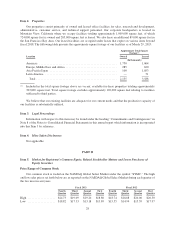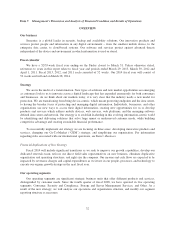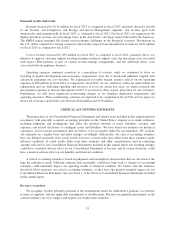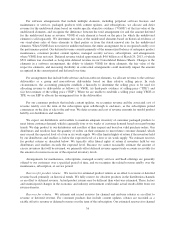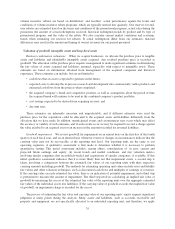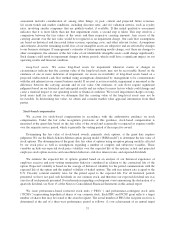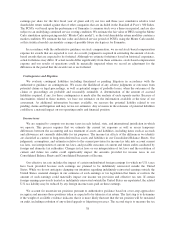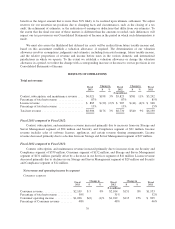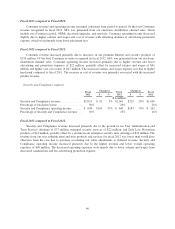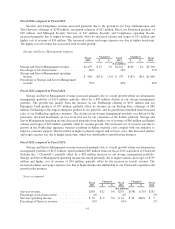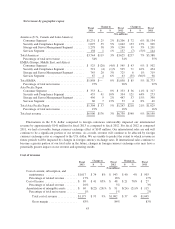Symantec 2013 Annual Report Download - page 135
Download and view the complete annual report
Please find page 135 of the 2013 Symantec annual report below. You can navigate through the pages in the report by either clicking on the pages listed below, or by using the keyword search tool below to find specific information within the annual report.assessment includes consideration of, among other things: (i) past, current and projected future revenues;
(ii) recent trends and market conditions, including discount rates; and (iv) valuation metrics, such as royalty
rates, involving similar companies that are publicly-traded, if available. If this initial qualitative assessment
indicates that it is more likely than not that impairment exists, a second step is taken. This step involves a
comparison between the fair values of the assets and their respective carrying amounts. Any excess of the
carrying amount over the fair value would be recognized as an impairment charge. Our cash flow assumptions
are based on historical and forecasted future revenue, operating costs, and other relevant factors. Assumptions
and estimates about the remaining useful lives of our intangible assets are subjective and are affected by changes
to our business strategies. If management’s estimates of future operating results change, or if there are changes to
other assumptions, the estimate of the fair value of our identifiable intangible assets could change significantly.
Such change could result in impairment charges in future periods, which could have a significant impact on our
operating results and financial condition.
Long-lived assets. We assess long-lived assets for impairment whenever events or changes in
circumstances indicate that the carrying value of the long-lived assets may not be recoverable. Based on the
existence of one or more indicators of impairment, we assess recoverability of long-lived assets based on a
projected undiscounted cash flow method using assumptions determined by management to be commensurate
with the risk inherent in our current business model. If an asset is not recoverable, impairment is measured as the
difference between the carrying amount and its fair value. Our estimates of cash flows require significant
judgment based on our historical and anticipated results and are subject to many factors which could change and
cause a material impact to our operating results or financial condition. We record impairment charges on long-
lived assets held for sale when we determine that the carrying value of the long-lived assets may not be
recoverable. In determining fair value, we obtain and consider market value appraisal information from third
parties.
Stock-based compensation
We account for stock-based compensation in accordance with the authoritative guidance on stock
compensation. Under the fair value recognition provisions of this guidance, stock-based compensation is
measured at the grant date based on the fair value of the award and is generally recognized as expense ratably
over the requisite service period, which is generally the vesting period of the respective award.
Determining the fair value of stock-based awards, primarily stock options, at the grant date requires
judgment. We use the Black-Scholes-Merton option pricing model (“BSM model”) to determine the fair value of
stock options. The determination of the grant date fair value of options using an option pricing model is affected
by our stock price as well as assumptions regarding a number of complex and subjective variables. These
variables include our expected stock price volatility over the expected life of the options, actual and projected
employee stock option exercise and cancellation behaviors, risk-free interest rates, and expected dividends.
We estimate the expected life of options granted based on an analysis of our historical experience of
employee exercise and post-vesting termination behavior considered in relation to the contractual life of the
option. Expected volatility is based on the average of historical volatility for the period commensurate with the
expected life of the option and the implied volatility of traded options. The risk free interest rate is equal to the
U.S. Treasury constant maturity rates for the period equal to the expected life. For all historical periods
presented, we have not paid cash dividends on our common stock, and therefore our expected dividend rate was
zero for all such periods presented. For information regarding a subsequent event announcing the declaration of a
quarterly dividend, see Note 15 of the Notes to Consolidated Financial Statements in this annual report.
We issue performance-based restricted stock units (‘‘PRUs’’) and performance-contingent stock units
(“PCSUs”) representing hypothetical shares of our common stock. Each PRU and PCSU grant reflects a target
number of shares that may be issued to the award recipient. The actual number of PRUs the recipient receives is
determined at the end of a three-year performance period as follows: (1) our achievement of an annual target
37



